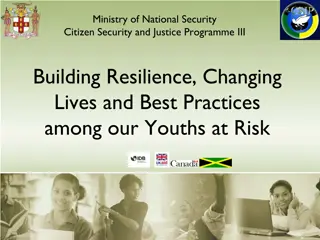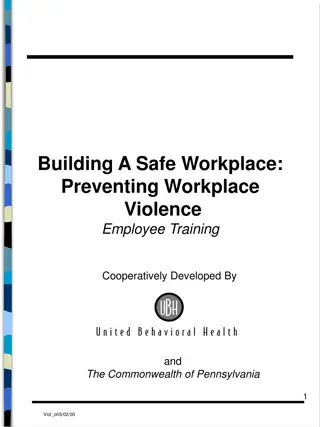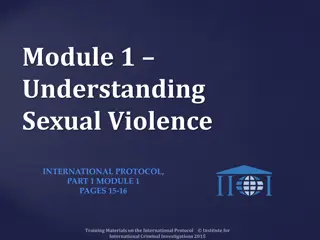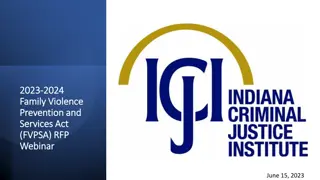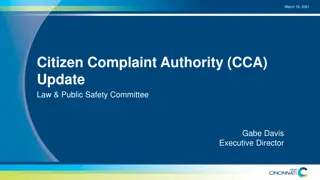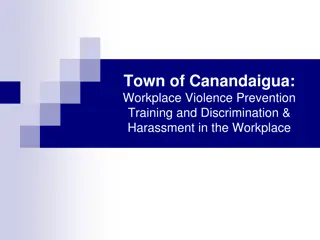Citizen Security and Justice Programme: Case Management for Violence Prevention
The Citizen Security and Justice Programme (CSJP) under the Ministry of National Security in Jamaica focuses on violence prevention through case management, risk assessment, and treatment plans. By targeting at-risk youth and implementing services such as education, psychological support, and peer assistance, the programme aims to address key risk factors and promote behavior change. With a strategic shift towards more robust targeting and sustainability, CSJP's approach emphasizes community involvement and tailored interventions for medium and high-risk individuals.
Download Presentation

Please find below an Image/Link to download the presentation.
The content on the website is provided AS IS for your information and personal use only. It may not be sold, licensed, or shared on other websites without obtaining consent from the author. Download presentation by click this link. If you encounter any issues during the download, it is possible that the publisher has removed the file from their server.
E N D
Presentation Transcript
CITIZEN SECURITY AND JUSTICE PROGRAMME Ministry of National Security CASE MANAGEMENT FOR VIOLENCE PREVENTION THE CSJP APPROACH
THE CONTEXT High levels of crime and violence in Jamaica CSJP - a multi-faceted crime and violence prevention initiative of the Ministry of National Security ; MOJ component Youth focus 17 to 29 years old Community focus vulnerable and volatile; 50 communities across 8 parishes Supported by GOJ via loan from IDB, DFID, Global Affairs Canada Started in 2001; will end 2019
THE CONTEXT, contd Lessons Learnt from previous phases and sustainability concerns led to Strategic Shifts More robust targeting Youth who are more prone to crime and violence perpetration Risk Assessment medium and high risk; low risk referred out Case Management
RISK ASSESSMENT Screening Risk Assessment Focus on 10 risk factors Protective Factors Factors are scored LOW, MEDIUM, HIGH Instrument developed for CSJP
RISK FACTORS History of violence History of non-violent offending Suicide/self harm Domestic violence Diagnosis for psychotic disorders, etc Anger management Thinking/Cognitive skills Alcohol/drug use Relationship with pro criminal associates Employment
CASE MANAGEMENT TREATMENT PLAN Multiple services: (i) Education/Training/Employment (ii) Psychological services (anger, stress, substance abuse, cognitive skills); (iii) Peer associates Case Officer: manager/coordinate treatment; conduct motivational interviews; review treatment plan; conduct reassessment Closure: completion of treatment plan/client drops out of programme
ASSESSMENT OF BEHAVIOUR CHANGE REASSESSMENT OF RISK FACTORS (i) main mechanism for assessing behavior change (ii) conducted 12 months after commencement of treatment (iii) Instrument slightly modified to consider review period
The Evidence So Far (Preliminary) KMA 1002 ACTIVE CLIENTS 314 REASSESSED 136 HIGH RISK 178 MEDIUM RISK
The Evidence So Far (Preliminary) Total High Initial Total High Moved Down % High Moved Down % High Moved Medium % High Moved Low %High Remain Same 136 84 62 51 11 38
The Evidence So Far (Preliminary) Total Medium Initial Total Medium Moved Down % Medium Moved Down % Medium Moved Low % Medium Moved High % Medium Remain Same 178 48 27 27 3 70
The Evidence So Far (Preliminary) ASSESSMENT OF RISK FACTORS 42 of the 136 high risk clients Domestic Violence: 33% showed improvement Anger Management: 36% showed improvement Thinking/Cognitive Skills: 33% showed improvement Substance Abuse: 26% showed improvement Relationship with Pro-criminal Associates: 52% showed improvement *****Protective Factors: 33% showed improvement
The Evidence So Far (Preliminary) ASSESSMENT OF RISK FACTORS Pro criminal associates HIGH MEDIUM LOW HIGH TO MEDIUM HIGH TO LOW REMAIN HIGH MEDIUM TO LOW REMAIN MEDIUM 17 22 3 10 4 3 8 18% 14 64%
CHALLENGES High Case and work load of Case Officers Weak capacity of partner service providers Inadequate incentives to attract persons involved in illegal income generating activities High level of substance abuse Community-wide and macro risk factors: unemployment, housing and sanitation, lack of variety of pro social recreational activities
POLICY IMPLICATIONS (preliminary) Focus on High risk; better return on investment *****ONLY IF IMPLEMENTED USING CASE MANAGEMENT Address community-wide and macro risk factors: parenting, unemployment, housing and sanitation, easy access to effective justice services; access to variety of pro social recreational activities
WAY AHEAD MNS committed to adopting case management MNS pushing for more community-wide pro-social activities sports and music




